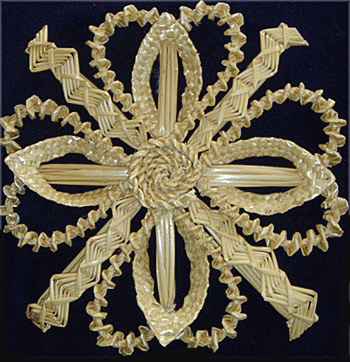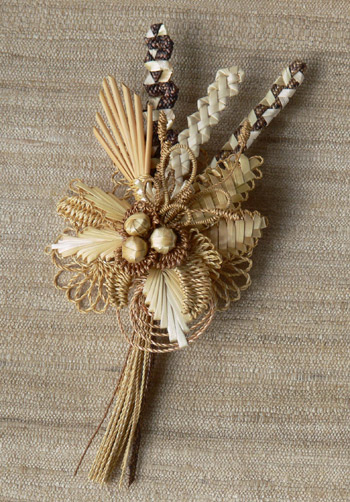History

Country Hedgerow, ©2005 Veronica Main,
Photo by Veronica Main
Even for the earliest civilizations success of a harvest has always been critical to survival. In the ancient mythology of many cultures there are tales of harvest celebrations and by the 1500s in Great Britain there are accounts of sheaves being decorated to represent the spirit of the harvest. By the late 1800s the making of harvest tokens seems to have been quite widespread throughout Europe.
Over the centuries straw in the form of grasses and cereal crops (wheat, oats, barley, rye and rice) were used for making straw hats, reticules, baskets, storage containers and a wide range of decorative items. From the 1600s, the straw hat industry provided income for families throughout Europe. It employed hundreds of thousands of people who made plait, wove hats (similar to Panamas), and made up hats either as a cottage craft or in a factory setting.
The knowledge and skills of working with straw were brought to America, their new homeland, by immigrant families. From the late 1700s, straw plait and loom-woven straw products were made for the important straw hat industry on the eastern seaboard of the States.These skills had almost become non existent by the 1970s. Fortunately, in the 1960s there was a revival of interest in straw art in Great Britain to record, recreate and develop new designs. The work is known as Corn Dollies, corn being the European name designating grain.
Techniques

Swiss Straw Work Brooch, ©2008 Brigitte Kilchmann, Photo by Brigitte Kilchmann
- Plaiting (pronounced with a short a) is known in the States as braiding. Modern straw workers refer to it as wheat weaving. There are hundreds of different plaits derived from other forms of braiding industries and from the straw hat industry. Plaits can be made from whole, hollow stems of grass or wheat, etc., or from split straw.
- Straw Marquetry can take many forms. It can be like wood marquetry where all the pieces join together to create a flat surface, or the straw pieces can be set into varnish as in the techniques of New Mexico, or the straw can be appliquéd onto a surface, or created as a mosaic. The whole straw is split open along its length then smoothed and softened so it becomes flexible. The strips are applied to a backing such as tissue paper, cardstock or even fabric to form a straw sheet. The straw sheet can be cut and reassembled into geometric patterns (parquetry) or decorative shapes, which are then applied to another surface to create items both decorative and useful.
- Swiss Straw Work was developed to produce trimmings and products to make into straw hats. The industry developed in Switzerland in the 1800s and continued until the mid 20th century. Today we incorporate these decorations into our straw art.
- Straw Embroidery dates back to the 1600s and probably before in Europe. The split straw is softened and worked through open weave fabrics using traditional embroidery stitches. In Switzerland and France in the 1800s split straw and two-ply straw threads, and plaits were couched onto velvet and other materials to make church vestments and altar frontals. Straw has been used to decorate costume from the 1600s.
- Tied Straw Work is most usually found in Scandinavia where whole straws are tied into traditional figures such as tomten and animal figures such as goats. In Germany and Switzerland the technique is used to make stars.
Tools
- Scissors and thread are the basics for working with straw.
- Smoother, scissors and brayer are the basics for simple marquetry. More complex marquetry will require the use of additional items such as graph paper, fine-bladed craft knife and metal straight edge.
- Straw splitters, dog combs and 3″ needles with a large eye are the basics for Swiss Straw Work and embroidery.
- Strong thread, or fine string and wire are the basics for tied, work.
Once you develop your skills you can add more and more tools, they are fun, but sometimes not essential. Many of the tools are ones you will already have in your home.
These techniques can be used separately or combined to create straw art from small pieces of jewelry up to large sculptures.
If you are just starting out in this craft then we will be pleased to help you find tool and equipment suppliers.
